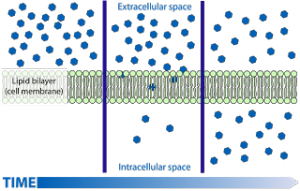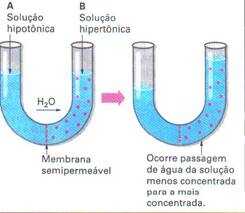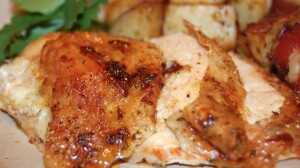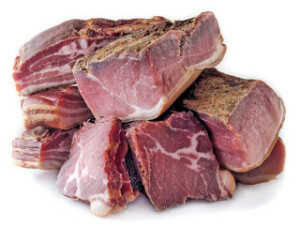A salmoura é uma solução de sal em água, que na charcutaria tem a intenção de preservação, intensificação de sabor e alteração de umidade dos alimentos, em especial das carnes. É muito mais rápida que a cura seca e carrega o produto com grande umidade e sabores de temperos adicionados à salmoura base. Há aqui duas vertentes que explicam o processo de migração do sal e da água para a carne, o primeiro relaciona a osmose como sendo o principal responsável pela migração da água e do sal para o interior da proteína, já a outra vertente alega que a difusão molecular é a responsável por esta migração.
Acredito que ambos os fenômenos químicos participem do processo, pois um não elimina o outro e ambos tem bases teóricas justificadas. Não há necessidade de discutirmos qual é o principal deles, mas sim de compreendê-los minimamente para entendermos os princípios químicos que transformarão o alimento, seja para consumo próprio ou comercialização.
Por que a salmoura deixa a carne mais suculenta?
A dissolução de cloreto de sódio(sal de cozinha) em água libera os íons de cloro(Cl-) e sódio(Na+), que penetram nas moléculas de proteína. Os íons de cloro acumulados na proteína provocam uma expansão das fibras musculares, abrindo espaço para o acúmulo de água. Já o acúmulo de sódio é que traz o sabor salgado. Portanto, quanto mais profundamente a salmoura penetrar na carne, mais suculenta ela ficará.
Parte desse ganho de líquido é perdido durante o cozimento, mas como a carne está mais inchada no início do cozimento, acaba mais suculenta do que ficaria sem esse ganho promovido pela salmoura. Podemos verificar que a carne absorve o líquido através de pesagem antes e após a salmoura. Normalmente pesam de seis a oito por cento a mais do que antes da salmoura.
Se o sal seca a carne, como a salmoura a deixa mais suculenta?
Enquanto concentrações de sal baixas provocam a expansão da proteína, concentrações de sal acima de 6% provocam o efeito contrário, retraindo essas fibras e expulsando os líquidos do seu interior, matendo-a seca e livre de microorganismos. Mas, caso a carne seja dessalgada e tenha sua concentração de sal reduzida para níveis abaixo de 6%, o potencial de retenção de líquidos será ampliado novamente. Nosso paladar costuma apreciar concentrações de sal entre 0.5% e 2% do peso total da carne, dependendo do paladar individual. Já tentou comer carne seca sem passar pelo processo de retirada do sal? Nem tente, será horrível tanto para seu paladar quanto para sua saúde.
Como o salmoura preserva a carne?
É sabido que a água é um dos ingrediente básico para a proliferação de bactérias, então como uma salmoura pode ajudar a preservar o alimento? Os micro-organismos, que causam o apodrecimento dos alimentos e produzem toxinas que afetam a nossa saúde, não sobrevivem num ambiente de elevada pressão osmótica, isto é, que lhes rouba a água por osmose, consequentemente, quanto maior a concentração de sal, mais protegido o produto estará. Mais uma vez, não cabe o debate sobre difusão ou osmose, pois independentemente do processo responsável pela incorporação do sal e da água na carne, a salmoura sempre possuirá pressão osmótica que afetará os microorganismos. A salmoura não vai proteger o alimento como uma cura com sal seco(que expulsa a água do alimento pela contração das proteínas), mas prolongará consideravelmente sua vida útil ao deixar o ambiente um pouco mais hostil do que a carne totalmente sem sal.
Compreender como funciona a salmoura é imprescindível para aplicá-la corretamente. Não basta jogar o alimento em água salgada sem levar em conta os tempos necessários para que os processos químicos ocorram como esperado. A quantidade de sal, o tamanho do alimento e o tempo de cura são fundamentais. Como a ação da salmoura é muito rápida, facilmente pode-se salgar excessivamente o alimentos.
Veja tabela com tempos de salmoura








Olá! Minha dúvida é quanto aproximadamente em média as carnes cruas absorvem de sal (NaCl) em uma marinada de cura úmida? E se for em uma cura a seco somente com sal e ervas em até 2 dias pegando tempero em refrigeração?
Vai absorver até equilibrar aconcentração de carne da água e da carne. O tempo varia conforme a concentração de sal contina na água e a espessura da carne. CArnes finas absorvem rápido, carnes grossas demoram mais tempo. O ideal é fazer a salmoura por equilíbrio: Salmoura por equilíbrio
Estou iniciando minha produção de bacon, queria saber quais equipamentos são necessários
Para o bacon vai precisar de um ambiente para defumar. Pode ser um defumador tradicional, um pit smoker ou uma churrasqueira que consiga adaptar. Caso queira usar fumaça líquida, só um forno já é o suficiente, pois precisará apenas de calor, sem fumaça. Precisa definir se vai defumar a queima da madeira ou usando uma fumaça líquida.
Olá boa noite.
Posso fazer a salmora para o pernil? Deixo somente na salmora 12 horas e depois colocamos temperos e deixo mais 5 horas?
Deixe por dias. Resfriado, com os seus temperos preferidos (mas não esqueça de mostarda). Não deixe de colocar açúcar na salmoura.
Tenho uma dúvida pra fazer uma salmoura pra 20 frango?
Para quantidades grandes o mais viável é fazer a salga nos frangos por injeção.
Olá por gentileza depois que o peru ficar por 24 hs na salmoura ele precisa ser lavado e temperado antes de assar ?
Oi Luciana, caso a salmoura já tenha sido feita com todos os condimentos então não precisa de mais temperos, caso contrário pode aplicar os demais condimentos que quiser. Lavar nunca é necessário.
Como fazer charque. Como fazer a injeção? O que devo botar na salmoura para o charque ficar vermelhinho: Temnho que por sal puro de pois da injeção???
Olá bom dia,é possivel temperar o bacon na salmoura em grande quantidade?
Em grandes quantidades acredito que o mais recomendado seja injetar os ingredientes e deixar refrigerado por 1 ou 2 dias antes da cocção/defumação.
Olá, para a salmoura posso substituir a água por outros líquidos tipo, cerveja, vinho ou cachaça. Isso poderia trazer algum risco a saúde?
Oi, pode substituir por uma bebida alcoólica sim, sem problemas.
Boa tarde,visto que é recomendado ouso de 50 g de sal por litro água;quantos litro de água por kg. de carne?
Bom Dia! Gostariadesaber como e feita a salmoura para remocao de fungos na carne
Sarah, esfregue um pano embebido em salmoura(20g sal/200ml água) para remover a contaminação indesejado. Seque bem e retorne para a maturação. Caso tenha uma cultura starter(ou yakult), borrife nos produtos para proteger de micro-organismos indesejados. Adicionalmente pode acrescentar uma colher de sopa de vinagre nessa salmoura.
Boa noite!!!
Eu gostaria de fazer a carne seca aquela usada em feijoadas, minha duvida eh:
Faço a imersão em água, sal, açúcar quais as quantidades por kilo quantos dias? e Depois disso eu coloco para desidratar a carne em sal em qual proporção e por quanto tempo??
Desconheço o processo correto da carne seca, mas acredito que não haja salmoura, apenas a salga. Concentrações de 5% de sal desidratam a carne, então sugiro que adicione pelo menos 5%(do volume da carne) de sal de cozinha seco e 2,5g de sal de cura por kg de carne e deixe desidratar e curar por uns 3 dias na geladeira. Após esse período pode deixar exposto ao sol mais uns dias se quiser. Mas como disse, não conheço o processo “oficial”.
Olá.boa tarde
Tenho uma dúvida Simples
Quando é falado salmoura 4% para pescados ( processo antes de defumar) , são 4% de sal fino proporcional ao peso da carne ?
10 kilos de pescados 400 GR de sal?
Provavelmente é em relação à quantidade de água, só tem que acertar o tempo. Se for filé fino ou posta espessa os tempos de imersão vão variar.
Eu colocaria em relação a quantidade de água heheeheh
Da nisso trabalhar anos em laboratório 🙂
Kandrus, você está certo, o correto é em relação à quantidade de água. Vou editar e corrigir a resposta ao Francis. Obrigado!
Estou montando uma galeteria + frangos e ja tenho um churrasqueiro. No entanto gostaria de uma opiniao alheia a dele. Devo fazer, temperar uns 100 frangos para assar ou colocar na brasa em um sabado por exemplo. Como devo fazer o processo… um por um ou ha como fazer o processo de salmoura para estas quantidades maiores ?
Desde ja agradeço, abraços
Marcelo
Na minha opinião o mais prático seja injetar a salmoura em um por um ou usar uma injetora e tumbler para acelerar o processo. Salmoura por imersão é mais lenta e requer espaço muito grande para essa quantidade.
Eduardo, o q seria tumbler? Nem no google achei algo a respeito. Muito obrigado. Roberto
Tumbler é um tambor rotativo usado na indústria para marinar, distribuir ingredientes e massagear a carne. Lembra o funcionamento das betoneiras misturadoras de cimento.
É uma betoneira de pernil de porco.. eheheheheh
Como faço para fazer carne de sol em 3 a 4 horas na salmoura,
boa noite eduardo gostaria de saber si posso a dicionar cloreto de sódio na salmoura para o charque quantos % para cada quilos de carne agradesso des de já obrigado! Arnaldo silva
Arnaldo, para o charque a forma de produção em larga escala que conheço é a seguinte: Pesa a carne: Água: medir o mesmo peso da carne Sal refinado: 23% do peso da carne Sal de cura: 1% do peso da carne Faz a salmoura e fileta a carne em 3 a 4 cm. Depois mergulha a carne na salmoura e por 12 horas massageia ela de hora em hora. Após as 12 horas escorre e empilha sobre um estrado que permita escorrer a água no fundo. joga-se sal grosso entre as mantas e monta pilhas de carne com 1 a 1,5 metros de altura. Durante 5 dias são feitos os tombamentos. O “tombo” é revirar a pilha colocando quem tá em cima prá baixo e quem tá embaixo prá cima. Depois dos 5 tombos lava prá tirar o sal e coloca por 2 dias em um varal de madeira prá secar ao sol. Depois disso tá pronto para cortar e embalar. Para produção caseira eu faço apenas com sal. basicamente uso muito sal no prato, deito os files sobre a cama de sal e cubro tudo (topo e laterais) com sal e deixo destampado uma noite na geladeira. no dia… Leia mais »
Oi Alexandre, adicionar sal de cura em charque é proibido, sendo fraude. O que é permitido usar sal de cura é o jerked.
Obrigado Alexandre Erich Klemm informação preçiosa a judou é muito!